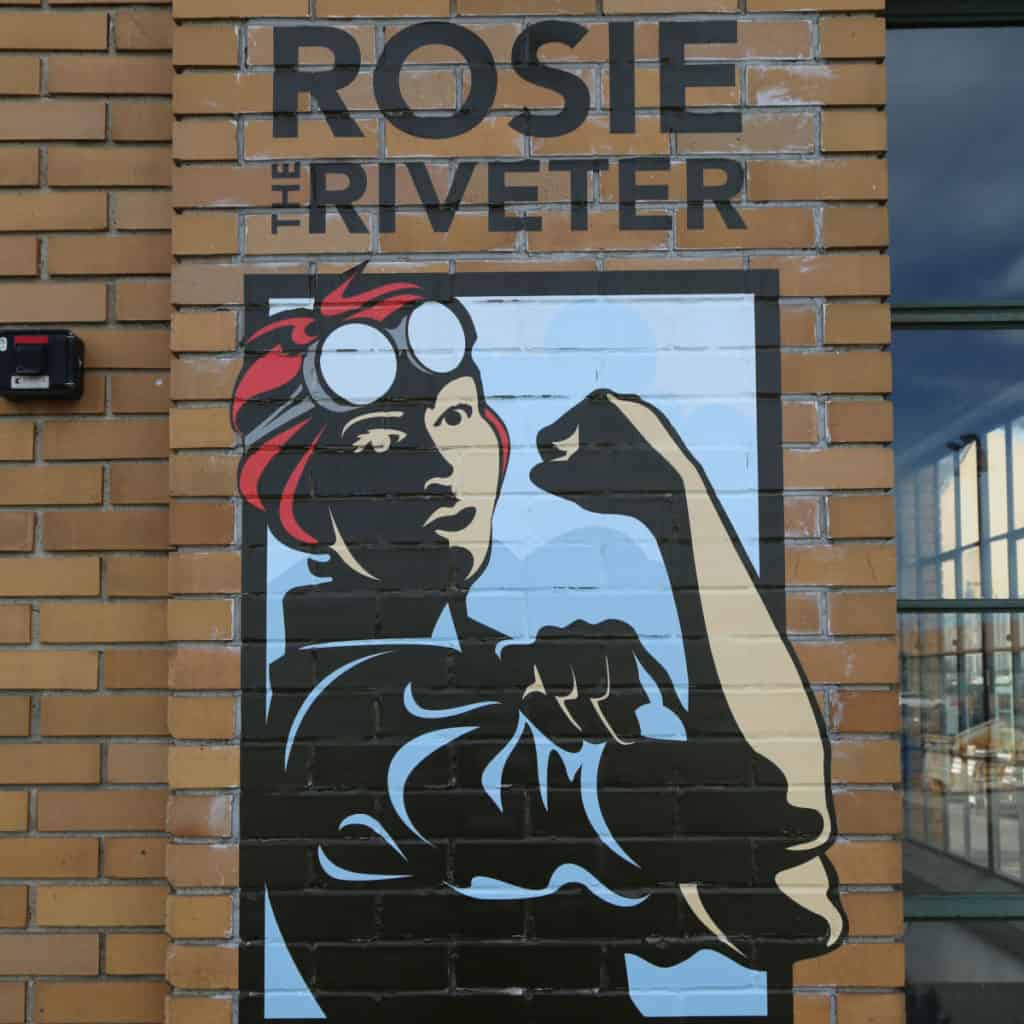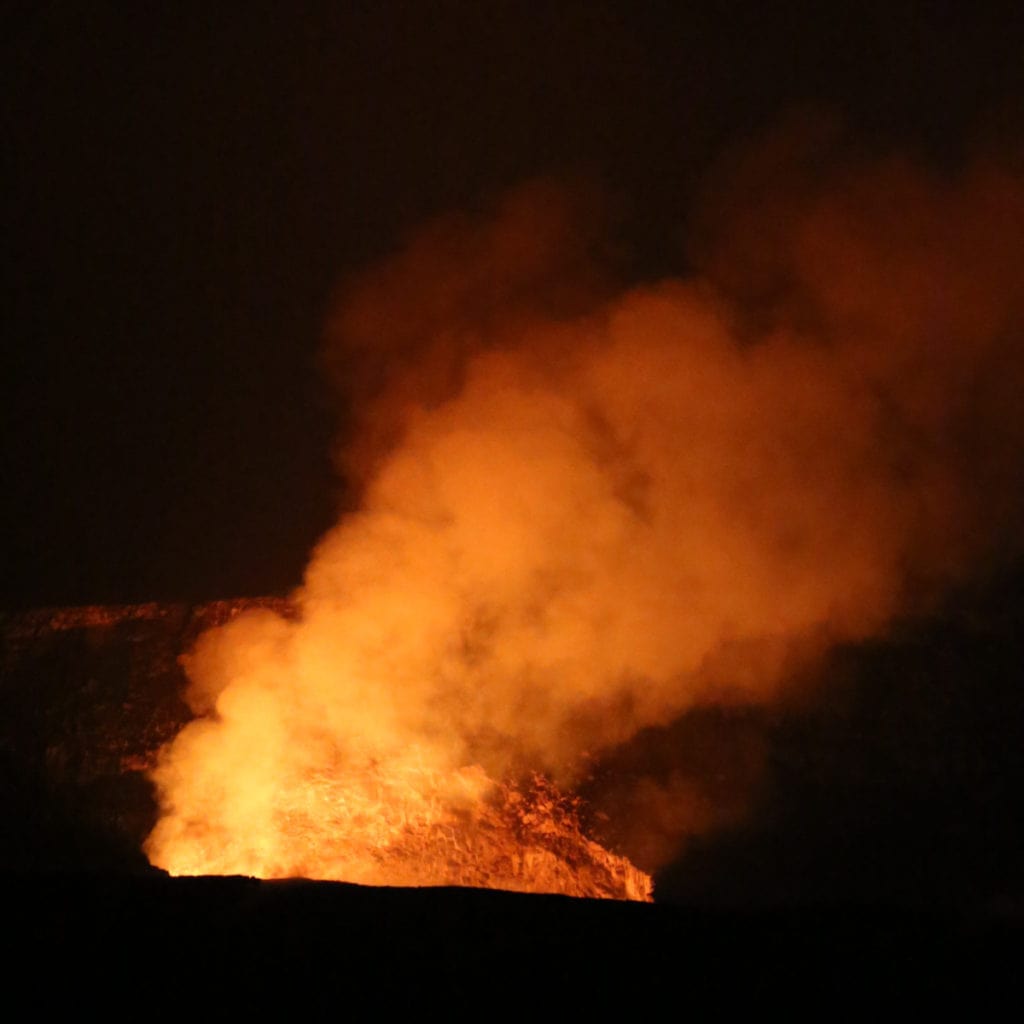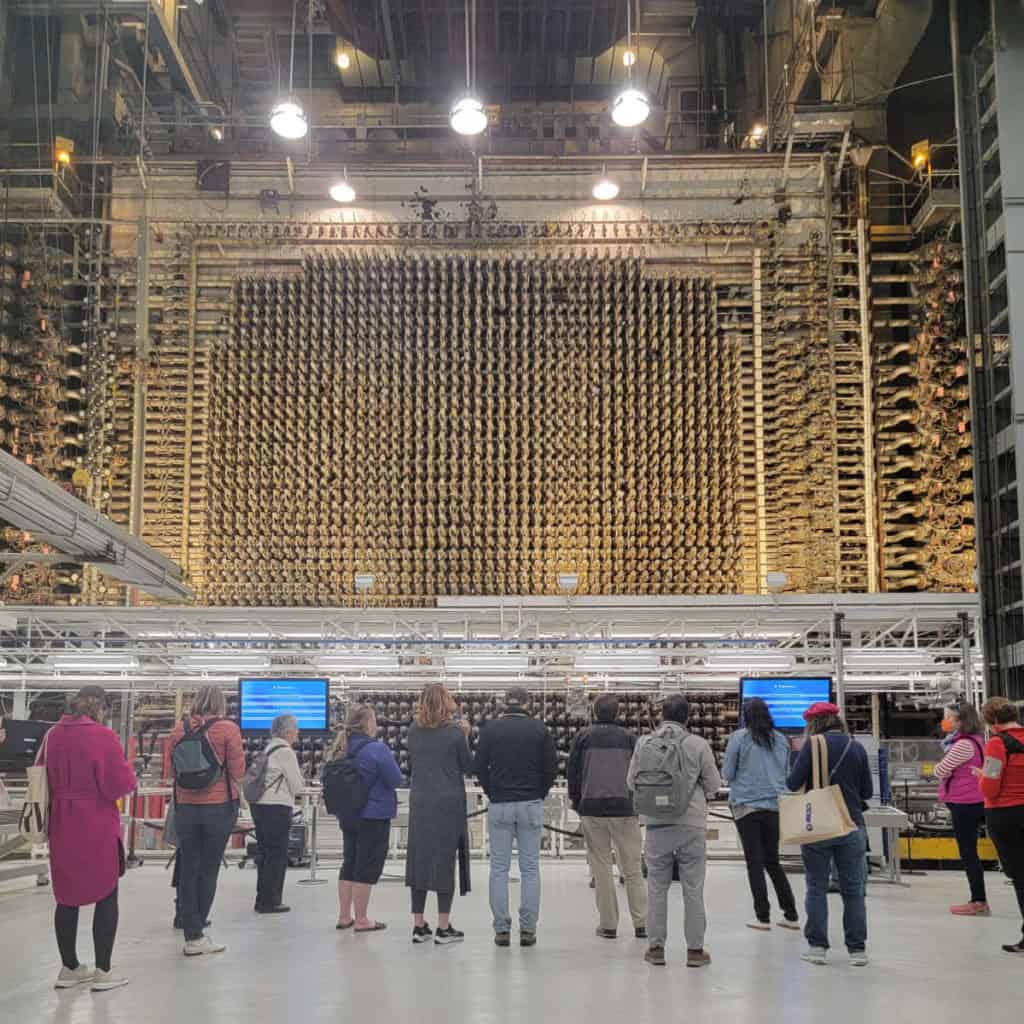Epic Guide to World War II National Park Sites, including home front and parks in the Pacific, Memorials, and the history of each National Park Site.

TL;DR Don’t have time to read the full article? Here are my top finds:
🏨Hotels and Vacation Rentals
📍Tours
🐻 Save time! Buy your National Park Pass before your trip
World War II National Park Sites
World War II was the deadliest conflict in human history. The war involved more than 30 countries from around the globe, leaving more than 75 million people dead, most of whom were civilians.
More than 400,000 Americans died in the war.
Initially, American President Franklin D. Roosevelt did not want to involve America in what began as a European war.
World War II broke out just two decades after the Great War (1914 - 1918), as America was recovering from the Great Depression.
On December 7th, 1941, the Empire of Japan attacked the U.S Pacific Fleet station at Pearl Harbor, Hawaii.
December 7th, 1941, became a day that would live on in infamy and thrust America onto the frontlines of World War II in the Pacific, Europe, and Africa.
President Truman promised that the American men and women who served and lost their lives during the conflict would not be forgotten.
The National Park Service has upheld President Truman’s promise. The sacrifices made by the American nation during World War II are forever commemorated through America's World War II National Park Sites.
The Beginning of World War II
The conflict that would claim an estimated 80 million lives, over 400,000 of which were Americans, began in Europe with Germany. The German nation had been economically devastated after the end of the First World War.
Germany had been the aggressor in the First World War and, as a result, was made to pay reparations to the European countries affected by the conflict.
At the end of World War I, the Treaty of Versailles stipulated that Germany not only had to pay reparations but could not reequip or rearm its depleted armed forces.
Germany had large portions of its territory taken away and all foreign colonies.
The terms of the treaty, coupled with the economic effects of the Great Depression, made Germany the perfect environment for Nationalism to flourish.
The head of the Nationalist movement in Germany was Adolph Hitler. Hitler and his National Socialist German Workers Party, or the Nazi Party, were soon the ruling party.
Hitler broke the terms of the Treaty of Versailles by rearming Germany and retaking territory lost in 1919. It was not long before Hitler started taking other areas that had never been part of Germany.
Hitler invaded Poland on September 1st, 1939. Two days later on September 3rd, Britain and France declared war on Germany, marking the beginning of the Second World War.

American Involvement
In 1940, Hitler allied with Japan and Italy. The three nations signed a pact and became the Axis powers. Italy reinforced the Germans fighting in Europe, and Japan brought the war to the Pacific.
America was not involved in the war raging in Europe by 1941, but it did send aid and military equipment to help France and Britain.
Roosevelt certainly did not want to involve the nation in another devastating conflict. The Empire of Japan would force Roosevelt's hand.
America had placed economic sanctions on Japan when they began invading territories in the Pacific.
In response, Japan planned an attack on America that would hopefully cripple the American fleet stationed in the Pacific.
Japan hoped that by crippling the Pacific Fleet, America would not be able to wage an effective war against Japan.
Shortly before 8 a.m. on December 7th, Japan attacked the U.S. naval fleet stationed at Pearl Harbor. The attack changed the course of history and the lives of the American people forever.
World War II Explored through America's National Parks
The attack on Pearl Harbor thrust the American people into another conflict that would prove even more devastating than the First World War.
Germany and Japan officially declared war on the United States on the 8th of December 1941.
In early 1942, U.S. troops were sent to the Pacific and Europe. Many of the troops were trained at sites protected by the National Parks Service.
Areas of historical significance and natural beauty suddenly had to serve as training camps for soldiers and spies and as testing grounds for new weapons.
The American National Parks Service has in its care several sites that memorialize the Americans who died during the conflict.
The World War II National Park Sites tell the story of the American nation at war.
Our debt to the heroic men and valiant women in service of our country can never be repaid. They have earned our undying gratitude. America will never forget its sacrifices.
-Harry S. Truman
The Parks in the Pacific
The war in the Pacific began on December 7, 1941. While the devastating attack on Pearl Harbor was taking place, Japanese forces were simultaneously conducting attacks on Thailand, Singapore, Malaya, and Hong Kong.
U.S. naval bases at Wake Island, Guam, and the Philippines, were also attacked.
The war in the Pacific was particularly violent. The Pacific theater is where some of the largest naval battles in history took place.
The war in the Pacific ended when America dropped two newly developed atomic bombs on the Japanese cities of Hiroshima and Nagasaki.

Pearl Harbor National Memorial, Hawaii
The Pearl Harbor National Memorial in Hawaii encompasses several areas of significance from the time of the Japanese attack on Pearl Harbor on December 7th, 1941.
The loss of life at the site was unlike anything the American people had experienced. In a few hours, over 2,400 Americans lost their lives.
The park preserves the battlefields of Ford Island and Oahu. 360 Japanese planes bombed Battleship Row and other military targets on Ford Island.
Several ships were severely damaged or sunk during the attack, including the USS Oklahoma, West Virginia, California, and Nevada. The USS Arizona sank with 1,102 sailors and Marines trapped inside.
The Japanese planes bombed Hickman airfield and military targets on Oahu. The aim was to ensure the Americans could not defend themselves in the sky.
The USS Arizona Memorial is the final resting place of the USS Arizona and the 1,102 crew members forever entombed in the ship. Despite the attack, Pearl Harbor was the center of U.S. operations in the Pacific.
War in the Pacific National Historical Park, Guam
The Pacific National Historical Park on the tropical Island of Guam preserves the land where so many lost their lives during the war in the Pacific.
Guam came under attack from Japan minutes after the attack on Pearl Harbor.
The Japanese planes bombarded Guam for two days before they landed on the island. Shortly after 400 Japanese soldiers landed in Guam, the governor surrendered the territory to the Japanese.
The area played a vital role in the U.S. Operation Forager in 1943. Operation Forager was the codename for the Mariana and Palau Islands campaign. The Marianas were Japan's line of defense in the Pacific.
The aim was to secure Japanese bases in the Pacific so that the United States could use them to launch bombing campaigns on mainland Japan.
The Battle of Guam was fought from July 21st to August 10th, when America recaptured Gaum. Over 21,000 soldiers died during the battle, 18,000 of which were Japanese.
American Memorial Park, Saipan
Situated in the Northern Mariana Islands, the American Memorial Park in Saipan commemorates the lives lost during the battles of Saipan, Tinian, and the Philippine Sea.
These battles were fought during the pivotal 1944 Mariana Campaign that aimed to cut off Japanese supply lines and break their island defensive line.
The Mariana Campaign marked the beginning of the end of the war in the Pacific. It was the American offensive to push Japan out of the territory.
It was from Saipan that the American B-29 bombers that would carry the atomic bombs to Japan were launched.
The Battle of Saipan began on June 15th, 1944 and raged for three weeks. The fighting was brutal during the battle, particularly around the highest peak of Saipan, Mount Tapochau.
Over 3,000 American soldiers lost their lives during the three-week-long battle. The Japanese losses were much higher, with a death toll of 27,000.
Just four days after U.S troops landed on Saipan; the Battle of the Philippine Sea began on June 19th. The battle was the biggest carrier-to-carrier naval battle in history.
The Americans shot down 480 Japanese planes and sunk two of their carriers.
While the Battles of Saipan and the Philippine Sea were raging, The Battle of Tinian began on July 24th, 1944. The first use of Napalm bombs happened at Tinian.
By August 1st, the island was under U.S command. 13,000 Japanese civilians were detained, and over 5,000 Japanese soldiers were dead.
The American Memorial Park honors the sacrifice made by the American servicemen during the Mariana campaign.
Aleutian World War II National Historic Area, Alaska
In 1943 Japan invaded the remote Aleutian Islands in Alaska. At the onset of the war, the Americans had built several bases on this 1,200-mile collection of islands. On June 3rd, the Japanese began bombing them.
The Japanese bombed Dutch Harbor, Fort Glen, and Adak airfields. The Japanese invaded the islands of Kiska and Attu shortly after, all of which now make up the Aleutian World War II National Historic Area.
The islands were home to the Aleut people, who were forcibly removed and interned in camps by the American government when Japan invaded. Some Aleut people were captured by the invading Japanese forces and sent to prisoner of war camps in Japan.
The United States successfully reclaimed the Alaskan Archipelago in August 1943. Despite this many of the Aleut people would never return to the islands.
The Aleutian World War II National Historic Area preserves eight historic landmarks that tell the story of World War II in Alaska.

Hawaii Volcanoes National Park, Hawaii
The Hawaii Volcanoes National Park is a UNESCO world heritage site where you can view the eruption of a volcano. The park has a long history, a history that did not go untouched by the events of World War II and the Japanese attack on Pearl Harbor.
The park housed a military base that became a Japanese internment camp after the events of December 7th, 1941.
Before the beginning of World War II, the FBI had compiled a list of all foreign nationals and immigrants from enemy territories. The list was called the "Custodial Detention List."
The people on the CDL were analyzed and categorized into groups, those considered to be threats and those who were not.
The people considered to be threats were to be immediately detained if war should break out. Those who were not deemed to be a threat could be observed rather than interned in a concentration camp.
Shortly after Pearl Harbor was attacked the Japanese Americans on the list who were considered a threat, were detained immediately.
Hawaii had a large population of Japanese immigrants, so placing the entire immigrant population in an internment camp was not feasible.
The first detainees arrived at the Kilauea Military Camp within the Hawaii Volcanoes National Park on the afternoon of December 7th, 1941.
Homefront
When Pearl Harbor was attacked, the American government and citizens sprang into action to protect their shores.
Many of America's National Parks along the coast became the first line of defense against enemy attacks.
The National Parks became a connection of radio and radar stations and defensive forts. Suddenly areas of historic military significance were to play a role in a conflict once more.
Below are the National Parks that were drafted into the U.S Armed Forces during our darkest hour.

Cape Hatteras National Seashore, North Carolina
Cape Hatteras National Seashore was the site of several German submarine attacks in 1942. The park was part of the coastal defenses during World War II.
In 1942 German U-Boats were extremely active in the waters around the Outer Banks.
387 merchant vessels were sunk by German U-boats in the first half of 1942 earning Cape Hatteras the nickname Torpedo Alley. Many lost their lives in Torpedo Alley during this time and several merchant vessels were sunk.

Rosie the Riveter National Historical Park, California
Rosie the Riveter National Historical Park tells the story of American mobilization on the Homefront. The park illuminates how the daily lives of Americans changed in the blink of an eye.
With many working-age men being drafted into the armed forces, the American government was looking for other people to continue America's war production.
Rosie the Riveter became the mascot for the American war production. This was the first time women and minority groups were being actively recruited for work.
This forever changed American society. The park explores how American society was changed forever by women and minority groups in the workplace and how this impacted the cultural landscape of American cities.
Every American was encouraged to do their bit for the war effort.
At Rosie the Riveter National Historic Park, learn how everyday Americans during World War II "Used it up -Wore it out -Made it do -or Did without."
Port Chicago Naval Magazine National Memorial, California
The Port Chicago Naval Magazine National Memorial commemorates the largest Homefront accident.
On July 17th, 1944, 320 men, almost two-thirds of which were African American servicemen, died in an instant when the ammunition they were loading to send to the Pacific front exploded.
Port Chicago was one of the largest U.S naval ammunition shipment centers and played a pivotal role in supplying ammunition to the Pacific front.
The massive explosion that rocked Port Chicago, was caused by a lack of training and substandard procedures.
The enormous explosion damaged every building in Port Chicago and destroyed the S.S. Quinault Victory and S.S. E.A. Bryant, and the pier.
The explosion highlighted the issue of unsafe working conditions found in Homefront operations.

Minidoka Internment National Monument, Idaho
When America declared war on the Empire of Japan and its allies on December 8th, 1941, tensions between Americans and Japanese immigrants and people of Japanese ancestry (Nikkei) increased drastically.
After the attack on Pearl Harbor, Americans viewed people of Japanese descent and immigrants as potential spies.
This led President Roosevelt to remove Japanese people, often American citizens, from American society with Executive Order 9066.
In 1942 Order 9066 was implemented, which meant that the United States government could forcibly remove Japanese Americans from their home and place them into internment camps.
Minidoka Internment National Monument was the site of one of these camps.
Japanese American families living on the West Coast were given notice that they had to leave their homes and relocate with only the belongings they could carry.
Japanese Americans from Washington, Oregon, and Alaska found themselves in the Minidoka concentration camp.
The park is also home to the Bainbridge Island Japanese American Exclusion Memorial, built by the Japanese Americans who were removed from Bainbridge Island.

Manzanar National Historic Site, California
Minidoka Internment Camp was not the only one of its kind. The United States government authorized the construction of ten camps to hold over 110,000 Japanese American men, women, and children.
The internment camps were constructed in remote areas of seven states.
Many of the people relocated to the Manzanar camp were American citizens or immigrants who had lived in the country for several years.
The camp's 10,000 residents were housed in 504 barracks. Life in the camps was harsh and uncomfortable for its residents.

Tuskegee Airmen National Historic Site, Alabama
The Tuskegee Airmen National Historic Site is where during World War II, the U.S Army Air Force experimented.
The experiment was to see whether African American men could be trained as pilots, serve in the Air Force, and fight in a war.
Women were also involved in the operation, working as mechanics, guards, secretaries, and more. Not surprisingly, the men and women at Tuskegee fulfilled their roles superbly.
The Tuskegee Airmen earned a reputation for being the best.

Catoctin Mountain Park, Maryland
Catoctin Mountain Park has been used for many things throughout its history.
During World War II, the recreation area was closed to the public, and the camp buildings were instead used to house soldiers and spies undergoing training. The camp hosted meetings between the Allies too.

Manhattan Project National Historical Park, Washington, New Mexico, Tennessee
The Manhattan Project changed the world. The Manhattan Project was the code name given to the research into and development of the atomic bomb.
The top-secret project began in 1942 and culminated in two atomic bombs being dropped on the Japanese cities of Hiroshima and Nagasaki in August 1945, effectively ending World War II.
The Manhattan Project National Historical Park encompasses the three important sites: Hanford, Washington; Los Alamos, New Mexico; and Oak Ridge, Tennessee.
Forts
When America went to war with Japan and its Allies, Germany and Italy, the defense of American shores became the top priority. Coastal fortifications once again became America's first line of defense.
Golden Gate National Recreation Area, San Francisco
The Golden Gate National Recreation Area formed a part of America's system of harbor defenses. Golden Gate was the center for Pacific coastal defenses
At the Presidio, there is a memorial to honor the 413 soldiers who were either lost or buried at sea during the war. San Francisco and the Bay area itself were considered likely targets for a possible Japanese attack.
The area was home to many military and industrial complexes and was a key point of transportation and manufacturing for supplies for the Pacific front.
The Golden Gate area was crucial to the American war effort, and so to protect it, an intricate coastal defense system was put in place.
The defenses included underwater mines, nets, weapons, and soldiers in coastal fortifications such as Fort Cronkhite and the coastal batteries dotted around San Francisco Bay.
Gateway National Recreation Area, New Jersey, and New York
Gateway National Recreation Area encompasses several key sites that were paramount to the defense of New York Harbor. The park consists of three units, these are Staten Island, Sandy Hook, and Jamaica Bay.
Each unit within the park preserves the site that tells a story of protecting America's largest port from attack. Jamaica Bay is home to the Floyd Bennett Field, New York City’s first municipal airport, and Fort Tilden.
Sandy Hook is home to America's oldest lighthouse and Fort Hancock, where more than 7,000 soldiers were based during the war. Both played a major role in defending New York Harbor.
Staten Island is the site of Fort Wadsworth, one of the oldest military facilities in the county. During World War II, the fort was armed with anti-aircraft guns.
Remembering Those Who Died
World War II remains the deadliest conflict in history. The horrors experienced during this time make it humanity's darkest hour.
The National Park Service oversees several memorials dedicated to ensuring all those who served in the war are remembered.
The parks exist to ensure future generations do not forget the men and women who laid down their lives to protect America's freedom.
The parks pay homage to the civilians who answered the call to aid the war effort on the home front to help America be victorious.

World War II Memorial, Washington D.C.
The World War II Memorial was commissioned to honor the 16 million American servicemen and women who served during World War II.
The site also commemorates the 405,000 members of the armed forces who died between 1941 and 1945.
The memorial also serves as a reminder of when the American nation came together to help the American war effort.

Franklin Delano Roosevelt Memorial, Washington D.C
Franklin Delano Roosevelt, often referred to as FDR, was the 32nd President of the United States of America.
Roosevelt was elected when America was experiencing the worst of the Great Depression. Roosevelt introduced a host of programs known as the New Deal to bring America out of the Great Depression and ease the impact.
Roosevelt led the American nation to victory during World War II and remained in office until he died on April 12th, 1945.
FDR played a crucial role in the Allies' relationships and had a great deal to do with providing the foundation upon which the United Nations was founded. Roosevelt remains the only President in American history to be elected four times.
US Marine Corps War Memorial, Arlington County, Virginia
The United States Marine Corps Memorial pays tribute to those who have served in the Marine Corps from its conception in 1775. The memorial takes the form of a statue. The statue depicts an iconic moment from the Battle of Iwo Jima during World War II.
The Battle of Iwo Jima lasted from February 19th to March 26th, 1945. The U.S made the capture of Iwo Jima a priority because of its proximity to mainland Japan and the three air bases that could serve as a base to launch an attack.
For five week's the battle was fought by the U.S. Marine Corps. The Battle of Iwo Jima was one of the fiercest and bloodiest battles of World War II. During the battle, 7,000 U.S Marines and almost 21,000 Japanese soldiers died.
The iconic image used for the U.S Marine Corps War Memorial was a picture taken on the afternoon of February 23rd. The U.S Marines raised a large American flag on the top of Mount Suribachi after clearing the mountain from Japanese resistance.
The world witnessed countless horrors during World War II. It was also a time of unity between the Allies and the American nation. The National Parks Service tells the story of American involvement in World War II on foreign shores and the Homefront.

List of World War II National Park Sites
- Franklin Delano Roosevelt Memorial
- Manhattan Project National Historical Park
- Manzanar National Historic Site
- Northern Mariana Islands American Memorial Park
- Pearl Harbor National Monument
- Port Chicago Naval Magazine National Memorial
- Rosie the Riveter WWII Home Front National Historical Park
- War in the Pacific National Historical Park
- World War II Memorial
World War II Training Grounds for Military Units
- Catoctin Mountain Park, Maryland
- Denali National Park, Alaska
- Hawaii Volcanoes National Park, Hawaii
- Mojave National Preserve, California
- Mount Rainier National Park, Washington
- Prince William Forest Park, Virginia
- Tuskegee Airmen National Historic Site, Alabama
- White Sands National Park, New Mexico
World War II Battle/Conflict Sites
- Aleutian Islands, Alaska
- Cape Hatteras National Seashore, National Seashore
World War II Military Recovery and Recreation Camps
- Bandelier National Monument, New Mexico
- Carlsbad Caverns National Park, New Mexico
- Denali National Park, Alaska
- Kings Canyon National Park, California
- Sequoia National Park, California
- Yosemite National Park, California
World War II Coastal Defense, Radio/Radar and Aircraft Warning Systems
- Acadia National Park, Maine
- Gateway National Historic Site, New York
- Golden Gate National Recreation Area, California
- Haleakala National Park, Hawaii
- Point Reyes National Seashore, California
- Redwood National Park, California
Presidential Sites Related to World War II
- Eisenhower National Historic Site, Pennsylvania
- Eleanor Roosevelt National Historic Site, New York
- Harry S. Truman National Historic Site, Missouri
- Home of Franklin Delano Roosevelt National Historic Site, New York
- John Fitzgerald Kennedy National Historic Site, Massachusetts
- George Washington Memorial Parks, Virginia (POW Interrogation Center)
- Franklin Delano Roosevelt Memorial, Washington DC
Additional World War 2 Resources
NEW YORK TIMES COMPLETE WORLD WAR II: The Coverage of the Entire Conflict
World War II: The Definitive Visual History from Blitzkrieg to the Atom Bomb
World War II History for Kids: 500 Facts (History Facts for Kids)
Make sure to follow Park Ranger John on Facebook, Instagram, Pinterest, and TikTok






Leave a Reply